Beyond Italy‘s iconic food, historic landmarks, and panoramas lies an underwater world few talk about. Among the Mediterranean blues, various shark species glide gracefully, calling Italian waters their home. While some might instantly picture ferocious predators, the reality is that many sharks in this region are gentle and rarely cross paths with humans. But it’s still a good idea to learn about them.
In this article, we’ll introduce you to the sharks most often spotted in Italian waters, from the small and unassuming to the larger, more recognized species. Whether you’re taking a dip off the Amalfi Coast or interested in marine life, this article will familiarize you with Italy’s most common sharks! So, without further ado, let’s get into it!
1. Blue Shark (Prionace glauca)
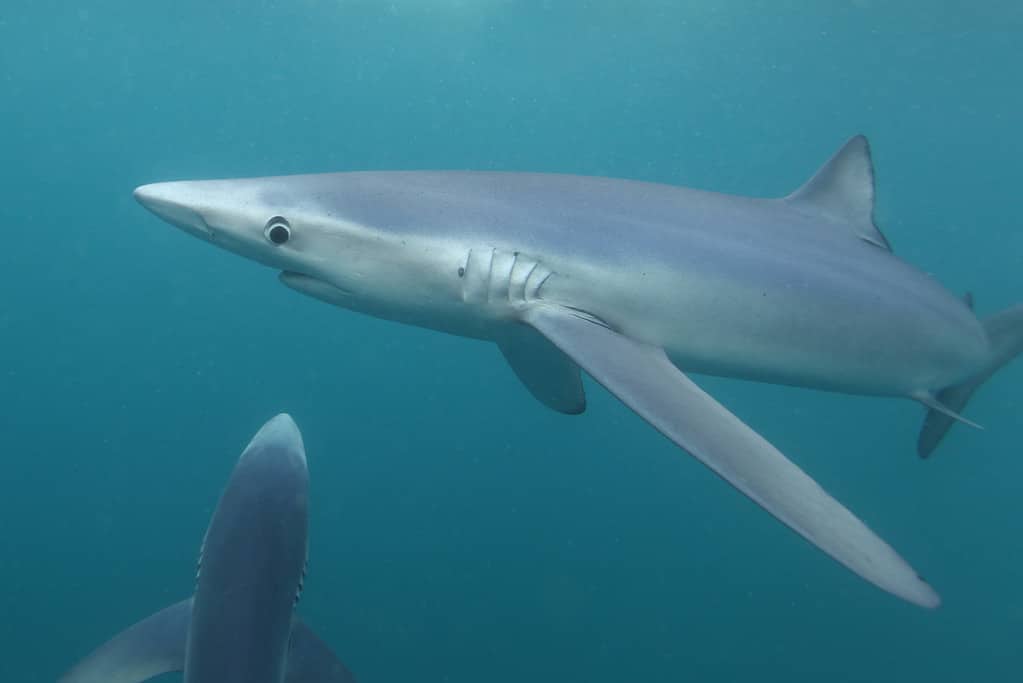
One of the most common sharks swimming around Italian waters is the blue shark.
©Alessandro De Maddalena/ via Getty Images
Blue sharks are frequently spotted in the waters surrounding Italy.
Typically measuring around 10 feet, these sharks can sometimes grow as long as 13 feet. Their back displays a vivid blue color, which transitions to a paler blue on their flanks and then white underneath. These sharks possess elongated bodies, pronounced eyes, and a pointed snout.
They have a preference for squids, and their dietary habits also include other sea creatures. They consume animals like cuttlefish, certain octopuses, and various shellfish, in addition to a variety of fish species.
Remarkably, blue sharks have an expansive habitat. They’re found across all the oceans, thriving in both temperate and warm regions, and can swim as deep as 3,280 feet.
Although uncommon, there have been instances where blue sharks have interacted with humans.
2. Great White Shark (Carcharodon carcharias)
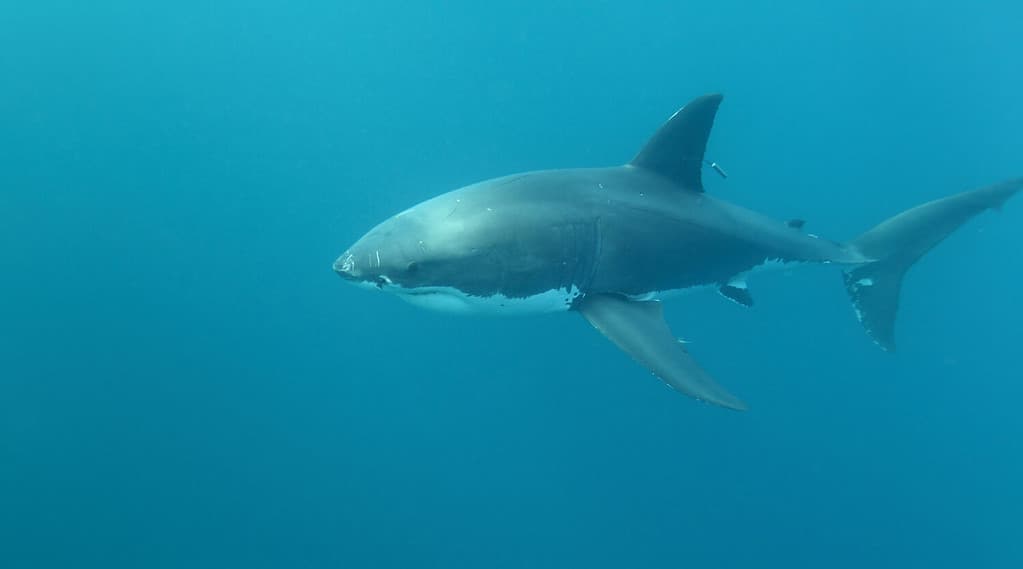
Another common shark in Italy is the great white shark.
©Alessandro De Maddalena/Shutterstock.com
Another shark that’s frequently observed around Italy’s shores is the great white shark.
This particular shark boasts a dark gray or brown upper body while its underside is noticeably white, which is how it earned its name. Like its counterparts, such as mako and salmon sharks, the great white has a streamlined body. Its snout is pointed, and a distinctive ridge can be seen near its crescent-shaped tail.
A female measures between 15 and 16 feet, while males are around 11 to 13 feet in length.
Diet-wise, great whites are versatile eaters. While younger sharks tend to feast on smaller fish, squids, and rays, mature sharks often gravitate towards seal and sea lion colonies.
You can spot these sharks close to the shore as well as in deeper, open waters.
Among all shark species, great whites are known for their aggression. They’re linked to 333 reported attacks on humans in history, 52 of which are fatal!
3. Shortfin Mako Shark (Isurus oxyrinchus)

An aggressive species, the shortfin mako shark can also be found in the waters surrounding Italy.
©Alessandro De Maddalena/ via Getty Images
The third shark often spotted in Italy’s coastal areas is the shortfin mako shark.
One of the standout characteristics of the shortfin mako is its colors. This shark sports a deep blue, sometimes nearing purple, on its dorsal side, transitioning to a silvery shade on the flanks and a white belly. Notably, the sharp contrast between the colors on the shark’s back and belly is easily distinguishable, with the area beneath their snout and mouth also being white.
These sharks tend to grow at a slow pace, with some reaching lengths of up to 13 feet.
Predominantly hunting near the surface, shortfin makos have a taste for marine fishes such as tuna, swordfish, and bluefish. They also occasionally prey on marine mammals and fellow sharks.
The preferred habitats for these sharks include warm and temperate surface waters. Younger makos tend to stick closer to the coasts, while mature ones venture farther offshore. Known for their migratory nature, they can cover vast stretches of ocean, spanning great distances.
These sharks have been known to become aggressive towards boats and those fishing, leading to injuries. Due to these tendencies, they’re seen as potentially dangerous, with records of both fatal and non-fatal encounters with humans.
4. Common Thresher Shark (Alopias vulpinus)
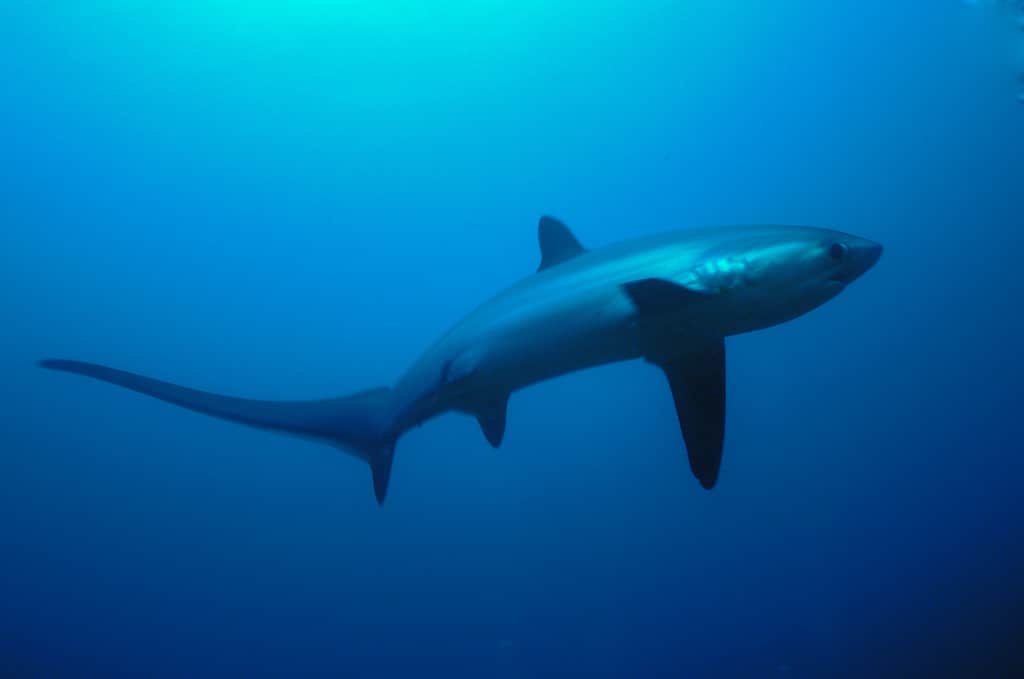
One of the most interesting-looking sharks in Italy is the common thresher shark, which boasts an elongated tail.
©aspas/iStock / Getty Images Plus via Getty Images
Another shark often seen around Italy is the common thresher shark.
These sharks exhibit varied shades, from browns and grays to a bluish-gray on their backs, which gradually fades to a lighter hue on their flanks and then to pure white on their undersides. The darker hues extend to their fins, and sometimes, subtle white streaks can be spotted at the tips.
They have the capability to grow to a striking length of 20 feet.
They primarily feast on small marine species such as mackerel, squids, sardines, and anchovies. One of their standout features is the distinctively elongated tail, which bears a resemblance to a reaper’s blade. This isn’t just for show, as they skillfully use it to slap and paralyze their prey.
Being avid travelers, these sharks often journey across vast stretches of the ocean. They prefer staying closer to coastal regions, particularly where there’s a high concentration of plankton, attracting an abundance of their favorite meals.
For those wondering about their temperament, thresher sharks are generally non-confrontational. Most divers who’ve had the privilege of seeing them up close attest to their docile nature. Even so, given their impressive size, a respectful distance is always recommended.
5. Tiger Shark (Galeocerdo cuvier)

With their aggressive reputation and behavior,
tiger
sharks are one of the most dangerous sharks in Italy.
©iStock.com/Divepic
Tiger sharks, known for their formidable presence, are frequent visitors to Italy’s coastal waters.
Featuring a wide, flattened head and a mouth that’s broader than its snout’s length, they also have distinctive long grooves on their lips. Their tail fin is sharp and elongated, enhanced with supportive ridges. Their teeth are uniquely shaped, bearing serrated edges with a pronounced notch.
These sharks can reach impressive lengths of up to 18 feet. When it comes to their diet, they aren’t picky eaters. From fish and other sharks to dolphins, seabirds, and even turtles, they have a varied palate.
They enjoy the warmth of tropical and subtropical regions.
In terms of their behavior, tiger sharks have a reputation. They rank just behind the great whites in terms of recorded attacks on humans, making them a species to approach with caution and respect.
6. Basking Shark (Cetorhinus maximus)

The second-largest fish in the world, the basking shark swims in Italy’s waters.
©Martin Prochazkacz/Shutterstock.com
Basking sharks rank as the world’s second-largest fish species and can be sighted in Italy’s waters.
Typically, they sport a grayish-brown color, sometimes displaying a patchy pattern. Their tail fin is uniquely crescent-shaped, accompanied by a pronounced side ridge. Despite having numerous tiny teeth, often totaling around a hundred in a single row, they aren’t used for typical feeding.
Coming close to the whale shark in terms of length, basking sharks can grow up to a massive 40 feet. They primarily feed on plankton. To do this, they swim with their mouths open, filtering plankton and tiny crustaceans using their dense, elongated gill rakers.
Preferring coastal areas, basking sharks roam the cold and temperate waters worldwide.
Contrary to what their formidable size might suggest, basking sharks are gentle giants, posing no threat to humans.
7. Great Hammerhead Shark (Sphyrna mokarran)
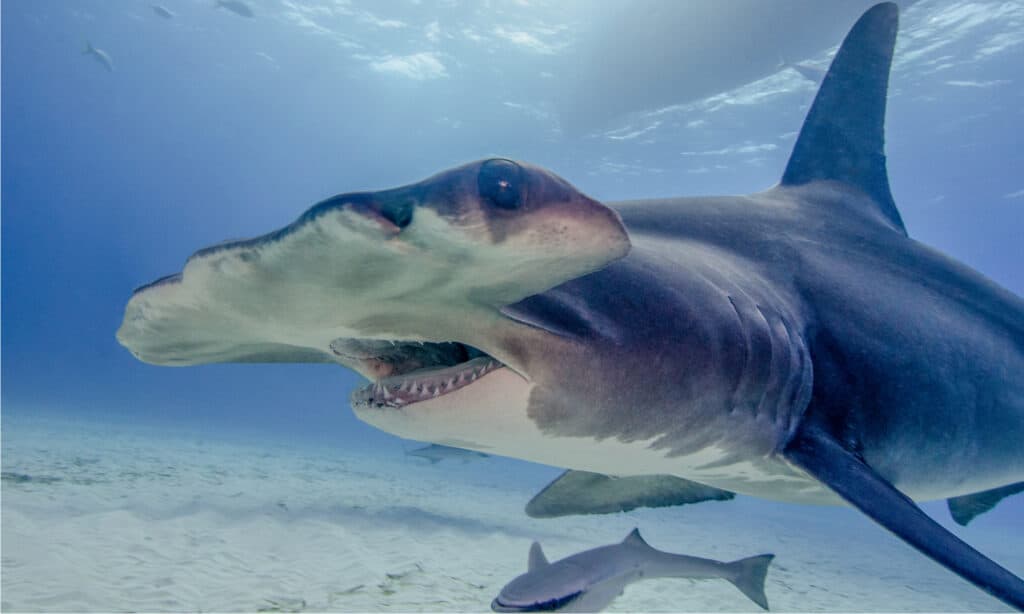
With its notable head shape, the great hammerhead shark definitely sticks out.
©Brent Barnes/Shutterstock.com
The great hammerhead shark is the largest among the hammerhead species and is commonly seen around Italy and the Mediterranean.
These sharks are easily identified by their T-shaped heads and the notably large and curved first dorsal fin. Their secondary dorsal fin is also significant in size, albeit smaller than the first, with a distinct inward curve. Displaying a dark brown or olive shade on their upper side, the color transitions smoothly to white on their belly.
Typically, a great hammerhead measures around 13.1 feet in length. Their preferred meals include stingrays, different types of skates, and even other sharks, sometimes including their own kind. They also feast on bony fish like groupers, sea catfish, squids, and various crustaceans from the ocean floor.
Known for their wandering nature, these solitary hunters are present across the Atlantic, Indian, and Pacific Oceans, with a notable presence in the Mediterranean.
Despite their intimidating appearance, hammerheads are quite shy. They aren’t known to attack humans unless threatened or if they mistake them for prey, like an injured seal.
8. Blackmouth Catshark (Galeus melastomus)
The blackmouth catshark is a frequent inhabitant of the Mediterranean Sea.
Recognized by its dark mouth interior, the shark also sports a distinctive pattern of light-bordered brown markings on its back and tail. Adding to its unique look is a serrated ridge of raised skin structures on the top edge of its tail fin.
Typically measuring between 20 to 25 inches in the Mediterranean, their diet is mainly composed of creatures from the ocean floor, including shrimp, lobsters, krill, cephalopods, and various fish species.
Warm waters worldwide host catsharks, making them the predominant shark species in many balmy regions.
Although their appearance might suggest otherwise, blackmouth catsharks are gentle creatures, posing no threat to humans.
9. Porbeagle Shark (Lamna nasus)
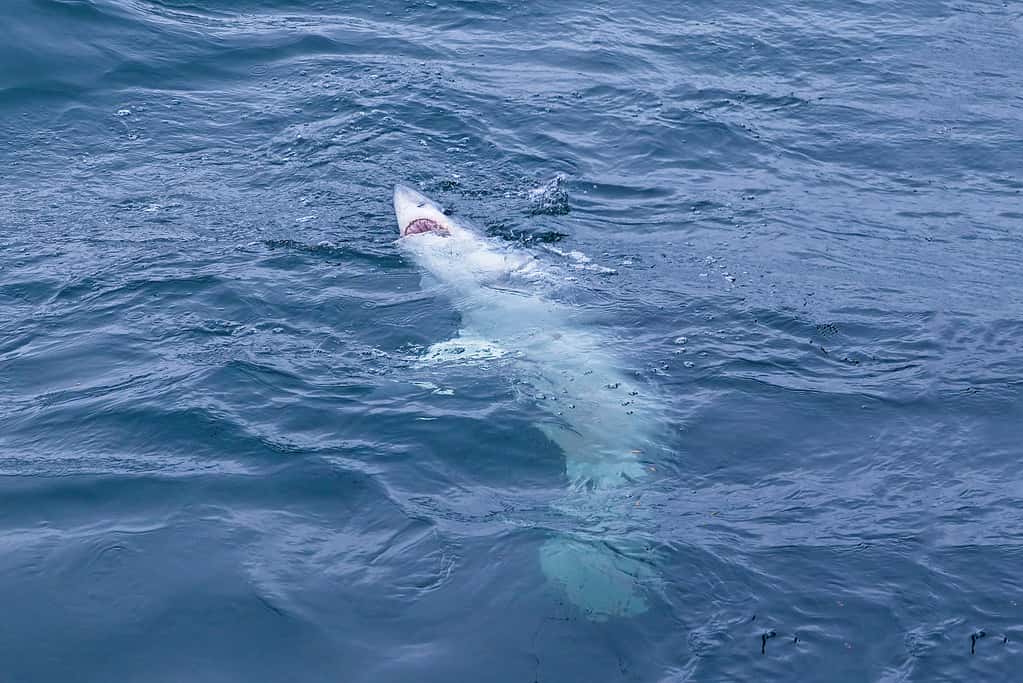
Often mistaken for a shortfin mako, the porbeagle shark can grow up to 12 feet long.
©birdsonline/ via Getty Images
Porbeagles, commonly mistaken for the swift-moving shortfin mako shark, are often observed in the waters around Italy.
Distinguished by its pointed snout and color contrast—dark gray on top and white below—the porbeagle’s name is believed to blend “porpoise” and “beagle.” This points to its rounded physique and persistent hunting technique.
Growing up to 12 feet, younger porbeagles predominantly feed on squid. As they age, their dietary preferences evolve, leaning more towards fish like mackerel, herring, hake, cod, and dogfish. Contrary to some larger species in their shark family, porbeagles don’t target marine mammals.
These sharks have a penchant for cool, temperate waters and have been found venturing as deep as 2,300 feet.
While they have the ability to attack, encounters with porbeagles resulting in aggression are exceptionally rare.
10. Sandbar Shark (Carcharhinus plumbeus)
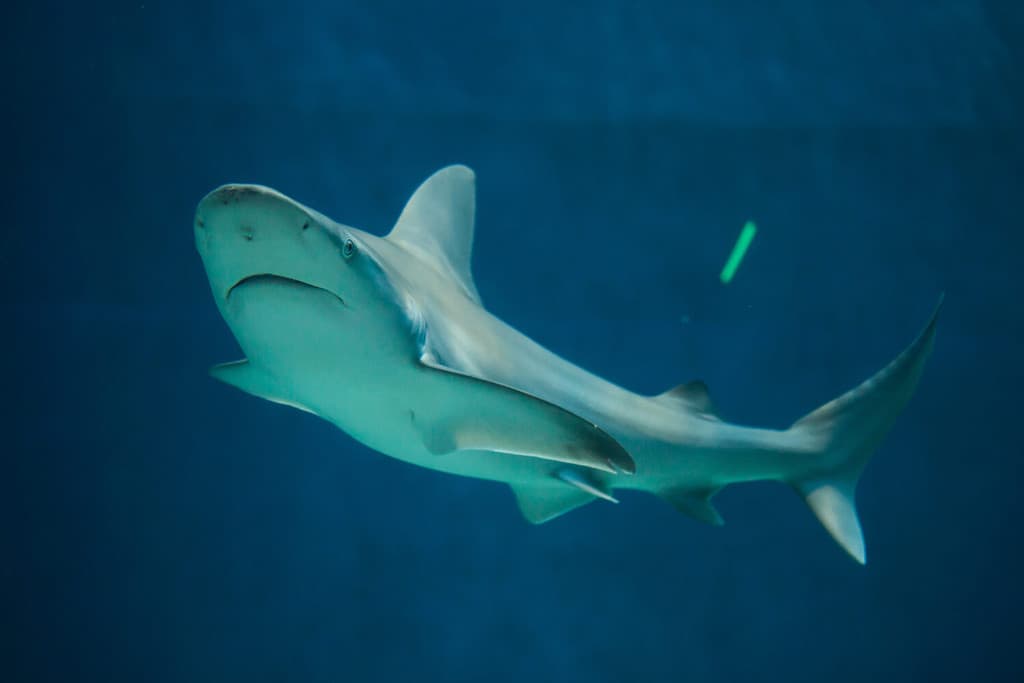
Another shark species you might spot in Italy is the sandbar shark.
©Vladimir Wrangel/Shutterstock.com
Since the 1950s, there have been sightings of sandbar shark gatherings around Lampione Island, particularly from July to November.
Sporting a brown or dark gray-brown color on top and a lighter belly, the sandbar shark is recognized by its rounded nose and unique, jagged teeth. Its notably high, triangular dorsal fin aids in balancing its swim, and a distinct ridge of skin stretches between its two dorsal fins.
Reaching lengths of about 7.5 feet, their primary food sources include bony fish varieties like menhaden, snapper, and croaker, complemented by crustaceans, including crabs and shrimp. On occasion, they might consume smaller sharks, rays, and even octopuses.
Sandbar sharks prefer the shallower coastal regions of continental shelves, islands, and estuaries with sandy or muddy terrains. They generally steer clear of freshwater environments.
Though they may resemble some of the more aggressive shark species, such as bull sharks, sandbar sharks are generally harmless.
Where to Spot Sharks in Italian Waters
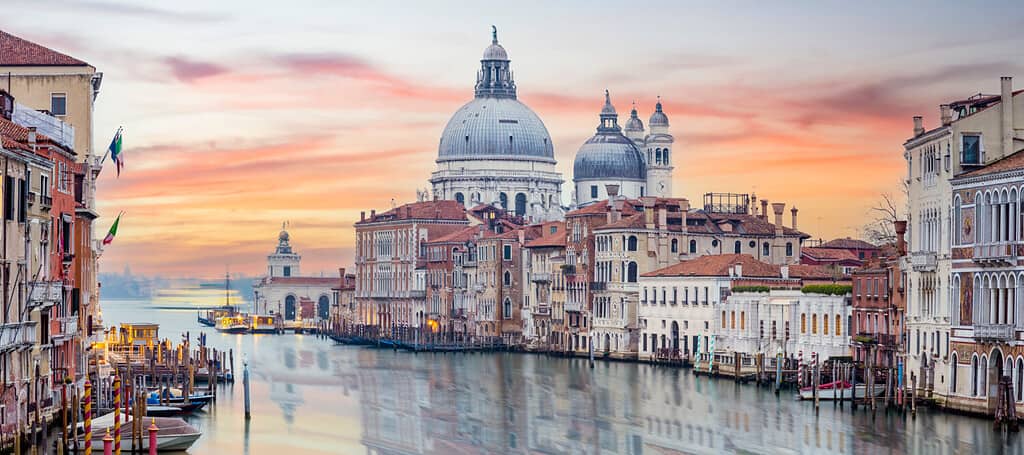
You might be able to spot sharks in Italy even in cities like Venice!
©travelwild/Shutterstock.com
Places like Genoa, Amalfi, and Palermo are prime locations for potential sightings. The deeper into the sea you venture, the higher the chances of coming across these majestic creatures.
Over the past three decades, there’ve been roughly 10 shark sightings near Italy’s coastlines, hinting at their limited presence.
In Italy, divers often share tales of encountering sharks, with the blue shark and great white shark being among the most mentioned. The Strait of Messina, in particular, is a hotspot for underwater meetings with blue sharks.
Over in Lampedusa, from August through October, it’s not uncommon to spot sandbar sharks and even great whites.
Beyond the Mediterranean, Venice’s river systems are another habitat for them. Given that most canals are about two meters in depth, it’s possible to spot them swimming about.
Other regions like the Tyrrhenian Sea and the Gulf of Naples also host these sharks. Specifically, for those keen on seeing a sandbar shark, Lampione Island is your best bet.
Most sharks in the Italian waters belong to deep-sea species, so casual swimmers or beachgoers won’t typically encounter them. They’re more commonly spotted by those in commercial fishing or with private tours.
Shark Attacks in Italian Waters
Shark attacks in Italy are quite rare, but they do happen. Surprisingly, among all the nations surrounding the Mediterranean, Italy has the highest number of reported shark incidents. Since the beginning of the 20th century, there have been 50 such incidents, with 11 unfortunately proving fatal.
Some notable recent occurrences include:
- In 2019, near Rome’s Lido di Ostia, a man was nipped by a shark. Though his injuries were minimal, the event understandably alarmed other beach visitors.
- A year earlier, in 2018, a woman faced a serious incident off the coast of Puglia in southern Italy. After being bitten by a shark, she endured significant injuries and required surgical intervention.
- On August 18, 2018, a 24-year-old male was bitten on the calf while playing in the waters of Chieti Province.
- In 2015, while diving, Eugenio Masala, 43, tragically lost his life in Sardinia. His demise was associated with a shark, but the exact circumstances remain uncertain.
- In a 2012 incident in Sardinia, Giorgio Zara, 57, got injured on his lower left leg while trying to help an ailing, stranded blue shark.
Summary of Sharks Found in Italian Waters
| Number | Shark | Scientific Nme |
|---|---|---|
| 1 | Blue Shark | Prionace glauca |
| 2 | Great White Shark | Carcharodon carcharias |
| 3 | Shortfin Mako Shark | Isurus oxyrinchus |
| 4 | Common Thresher Shark | Alopias vulpinus |
| 5 | Tiger Shark | Galeocerdo cuvier |
| 6 | Basking Shark | Cetorhinus maximus |
| 7 | Great Hammerhead Shark | Sphyrna mokarran |
| 8 | Blackmouth Catshark | Galeus melastomus |
| 9 | Porbeagle Shark | Lamna nasus |
| 10 | Sandbar Shark | Carcharhinus plumbeus |
The photo featured at the top of this post is © Brent Barnes/Shutterstock.com
Thank you for reading! Have some feedback for us? Contact the AZ Animals editorial team.






